Common-Works 4.2
Amsterdam
2020
As an ongoing edition-based performance project Common-Works deals with the development of collective, semi-improvised movement practices that aim to re-locate notions of discourse and representation within collectively experienced intensities such as flow, embodiment, notions of becoming and collective trance.
The score-edition was performed on Thursday 22nd / Friday 23rd October 2020, at Veem - House for Performance.
In collaboration with Lorena Solís Bravo, Mylan Hoezen, Julius Frodermann, Eli Steffen, Alexander Blum Bertelsen, Ioanna Mitza, Sam Scheuermann and Polina Fenko Concept Timothy Nouzak In conversation with Freda Fiala Supported by Veem - House for Performance, Flemish Cultural Center de Brakke Grond, ROSAS/PARTS - Studios Creation Support and WEMOVE.
The body as a medium, in all its ephemerality, immediacy and political urgency generates logics and knowledges that often refrain from rational conceptions. The current edition strives to look for new ways how meaning can arise by subverting rational tendencies and going for the embodied-affective. The score is thereby understood as a speculative space, an „in-between“ where meaning seems to consist of multiple possibilities all single-handedly looking for their future becomings:
Meanwhile, the common nominator is the collective.
Meanwhile, the common nominator is the collective.
How can collectivity attain a different dimension through means of collective listening and sensing?









I - This is a story about lost facts.
The work starts in conversation by means of collective, discursive practices that lead to a mapping out of interests: enter from the periphery and give all the materials the same value. The map shouldn’t occupy or gate a territory but focus on the flights in-between: about the proximity and/or distance between the subjects and concepts. Go wild but focus on the relation. See the map as a choreographic floorplan, where the object of perception, the future situation is.
Upon finishing think about a newly imagined or already existing practice of yours that connects to the map that has been prior created. See it as a performative statement, a single operation or state in which you describe and later on physically address your practice to a selected viewer. Beside movement, verbal language, written or spoken text may be included. Try not to work with props, etc. - keep it short, simple and embodied.
II - Sharing stories and hearing stories.
Continue to share the practice that you have created with several members of the audience, slowly start to merge each others practices, by linking other peoples endeavors till you arrive together into different forms of loose shaking. See shaking as a poetic practice. Strive to find one collective movement quality by carefully listening and sensing how intensity of the collective changes.
See the collective thereby as a transition-space that gives rise to new ideas, thoughts metamorphoses and performativities. See it as a place of old encounters, new interactions, of physical and metaphysical approaches somewhere „in-between“ fact and fiction, the „Self“ and the „Other“, visibility and invisibility, inside and outside, introspection and oberservation … center and periphery.








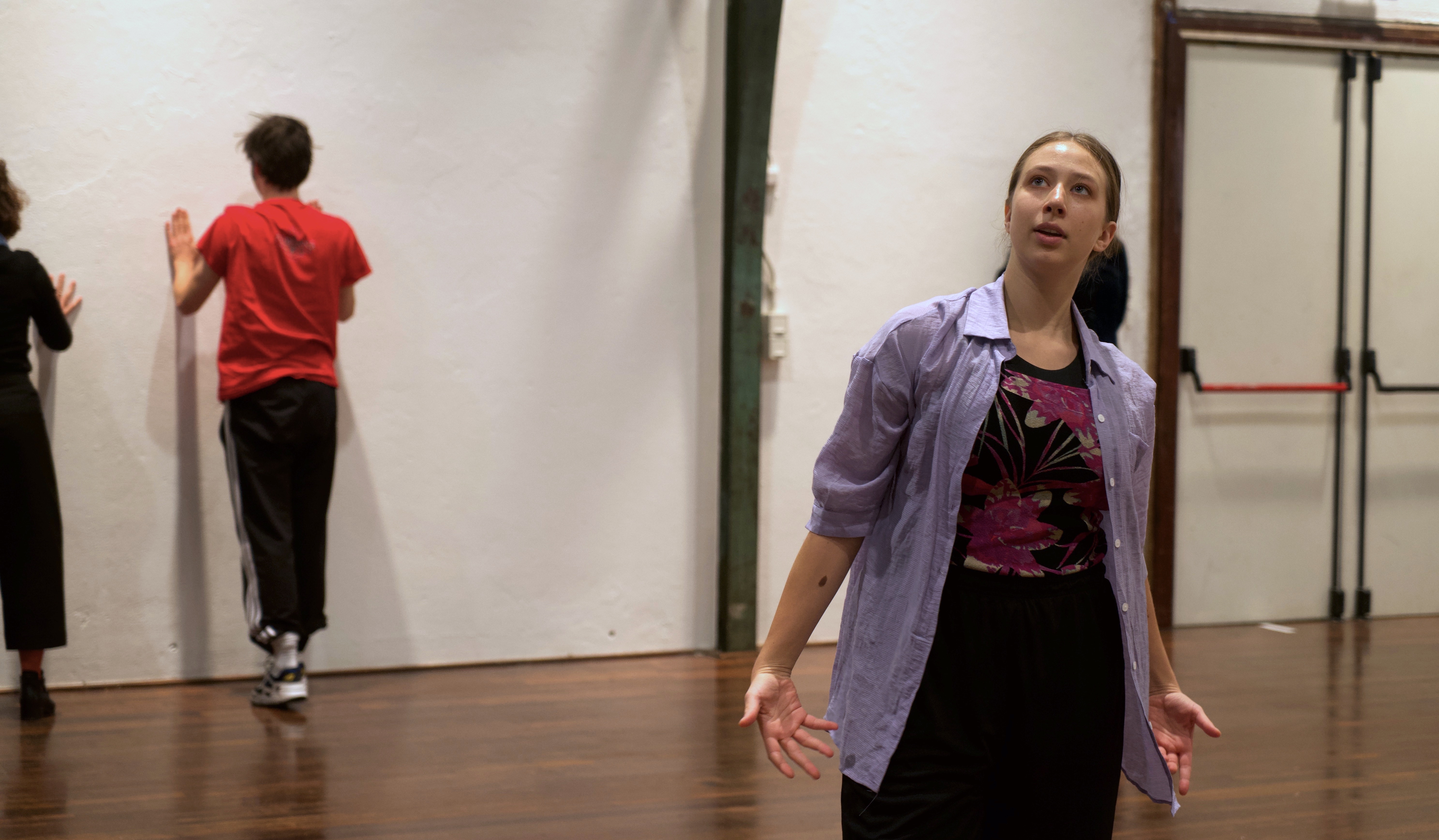




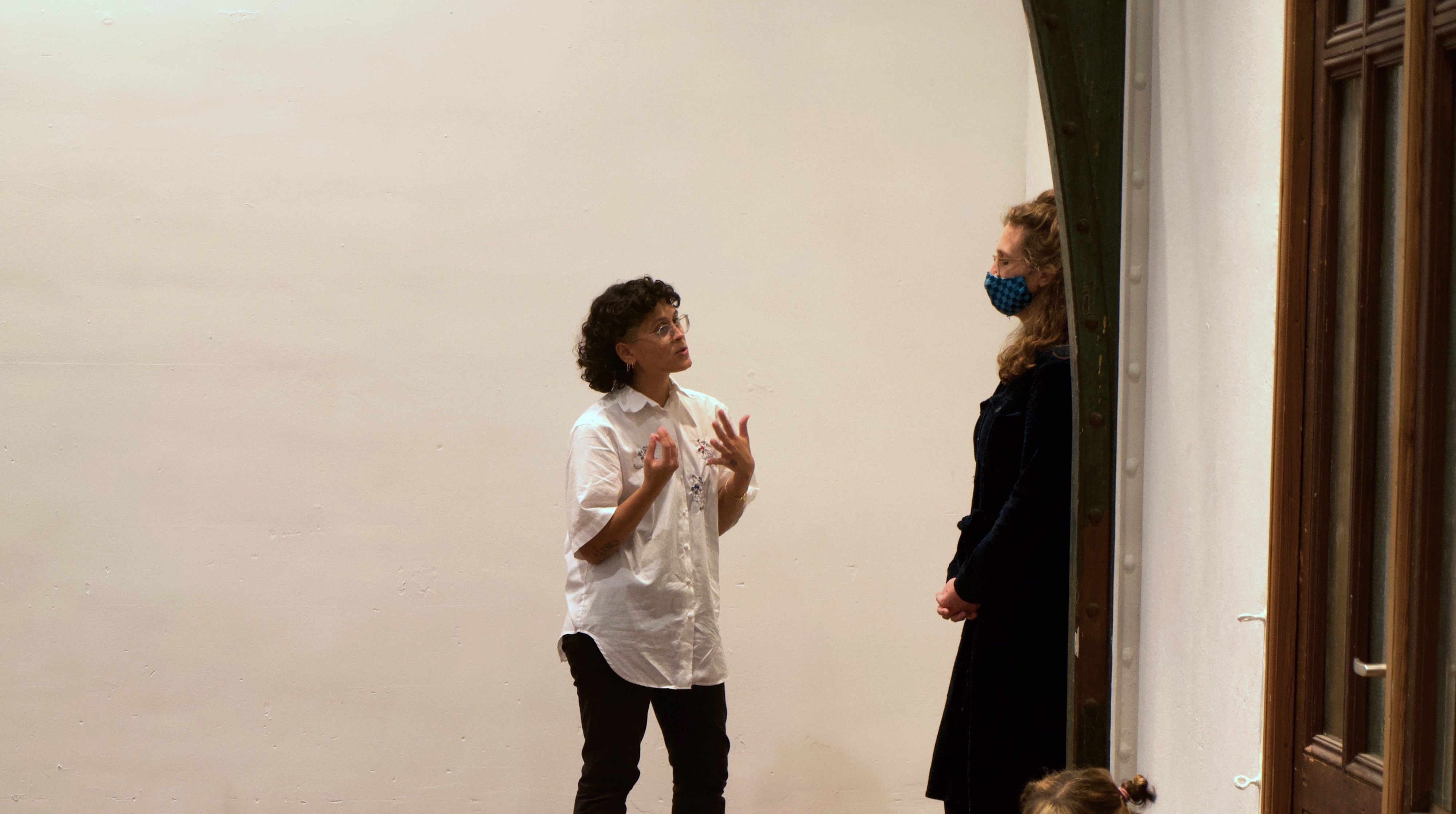
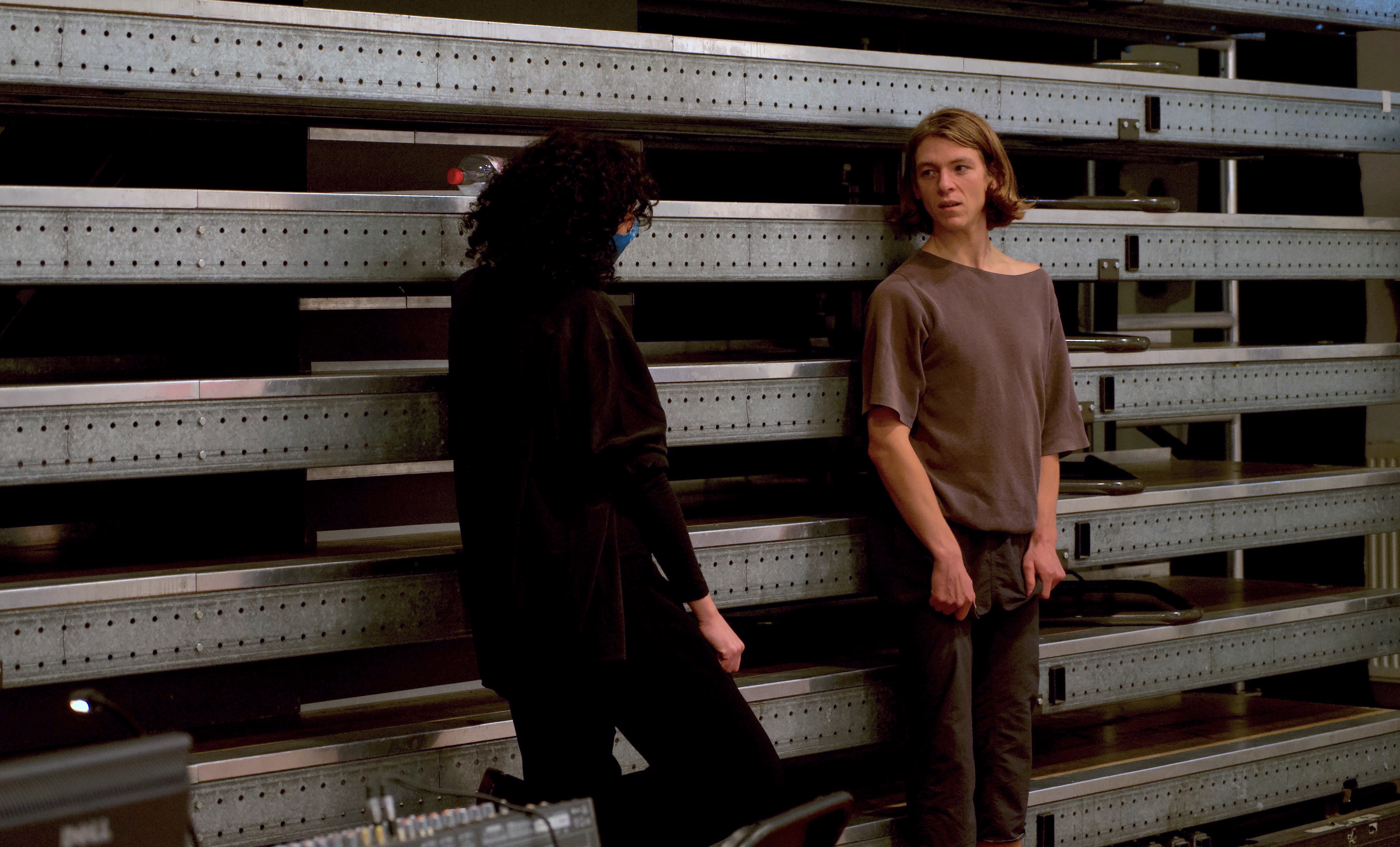




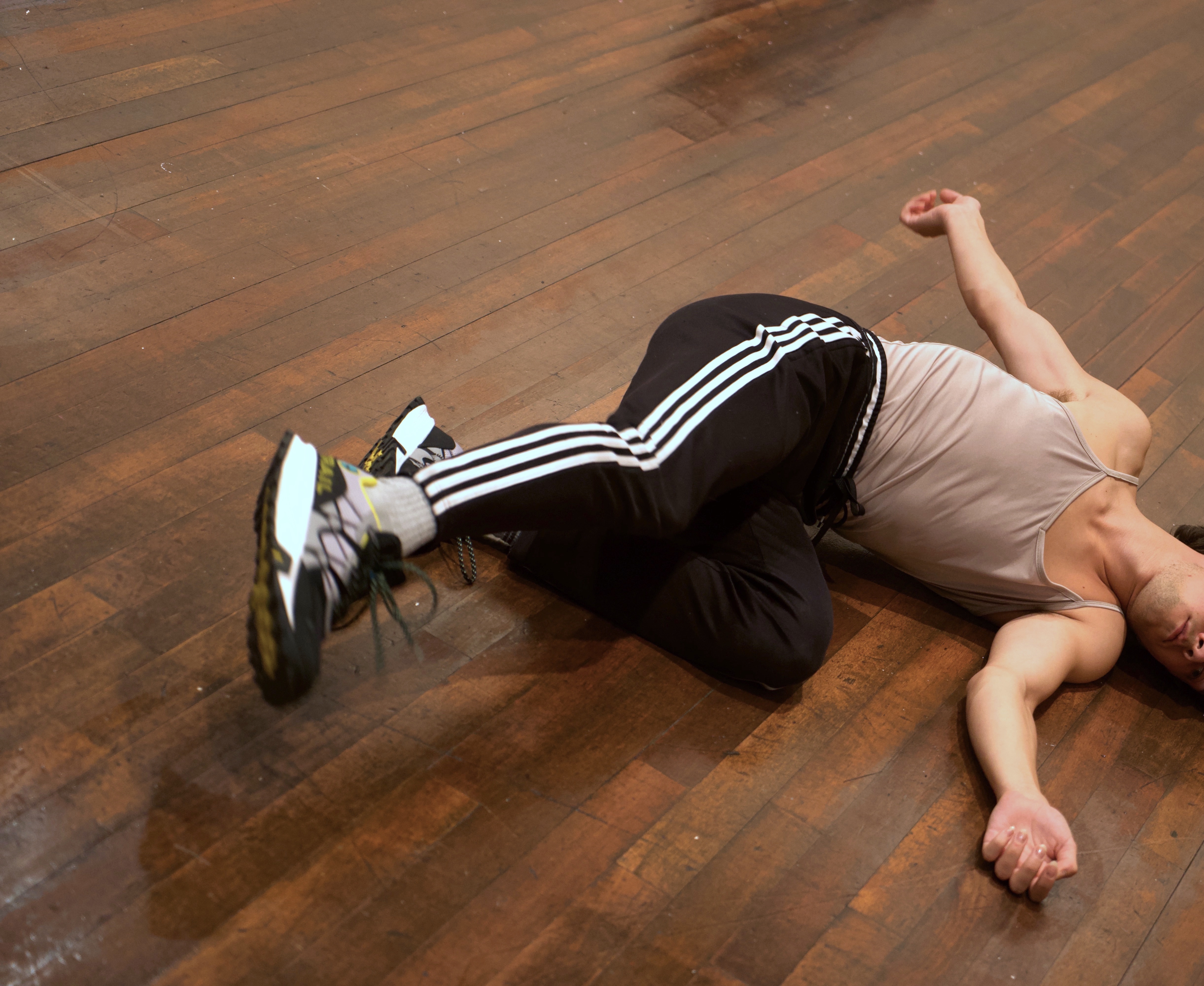


III - Re.verb.
Start to slowly intensify the shaking. Once you arrive to a point where exhaustion takes over, let the rhythm of the breath come into the foreground. Keep pushing. Once you arrived at an energetic zenith try to slowly calm down till the shaking modulates and becomes near stillness.
From this moment, the movement-score sets the communal conversation into the foreground by transgressing from an individual inquiry about ones own personal practice towards collective practices that pick up shaking as a means to reconnect to the body, to let the body speak, to let the body think and to let the body communicate through the work.
IV - Immersive spaces.
Once you have arrived to near stillness, start with a nearly imperceptible rocking motion. Decide beforehand collectively on one shared vector and start rocking back and forth all together, in the same pace. Take your time and change the amplitude incrementally by raising the intensity. Keep pushing together by being together. Don’t shy away from exhausting yourself and/or the image.
At a certain point, let the breath come into play. As you rock all together, the breath is to be kept together like a choir. Once the image has arrived on its zenith, slowly fade down the movement but keep the breath on the same intensity. Arrive to physical stillness but keep the breath on its highest intensity.


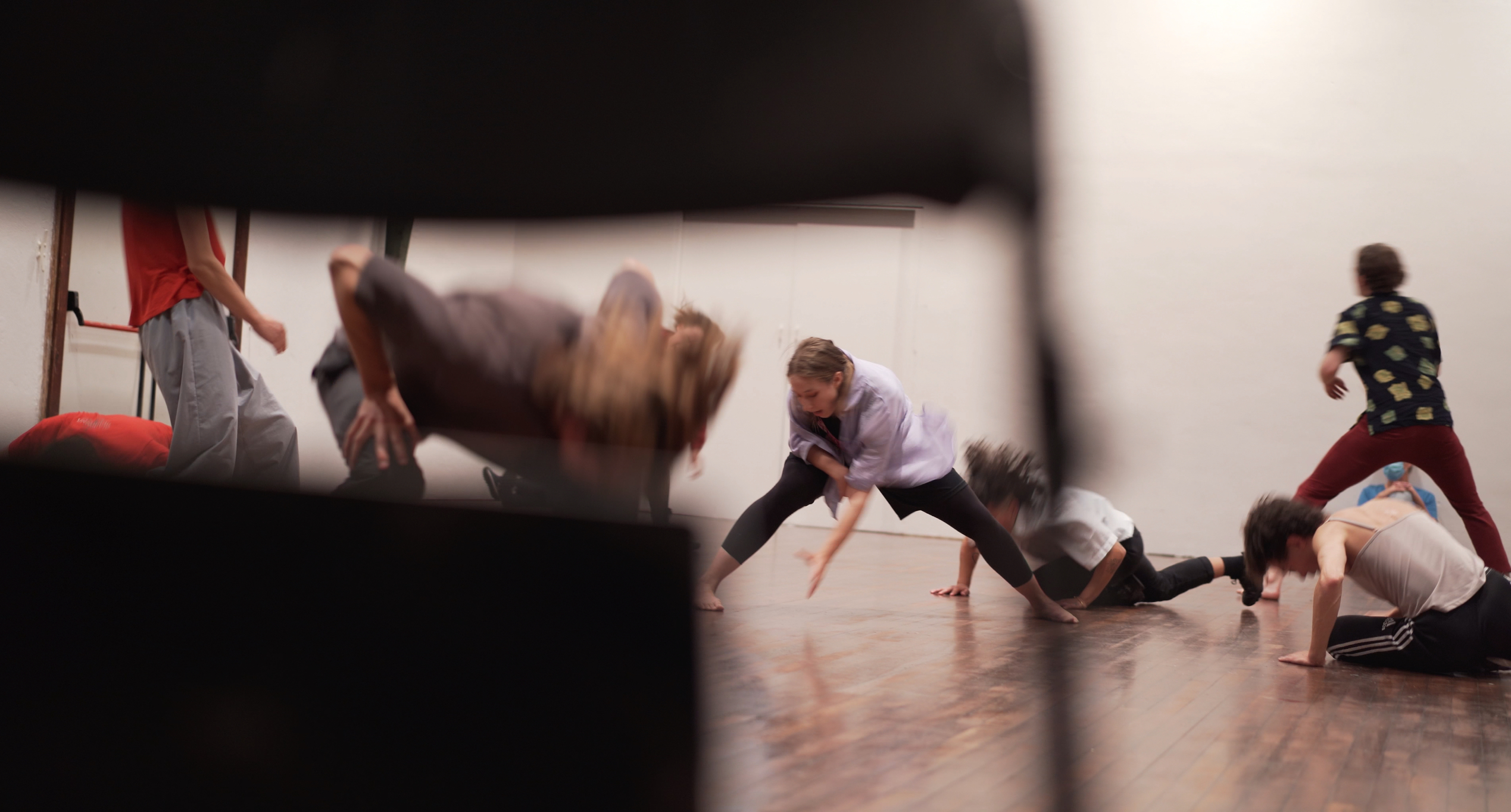
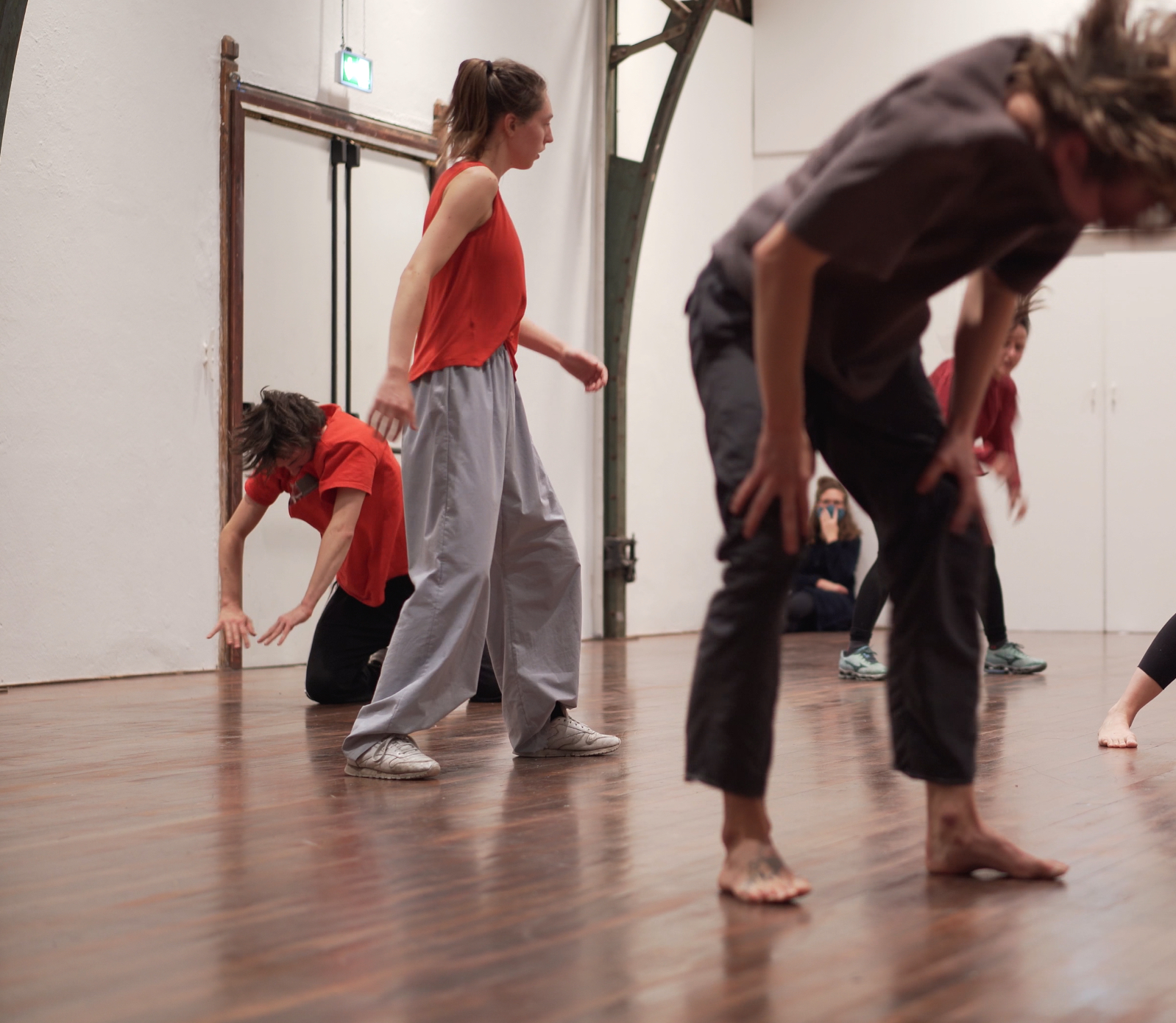
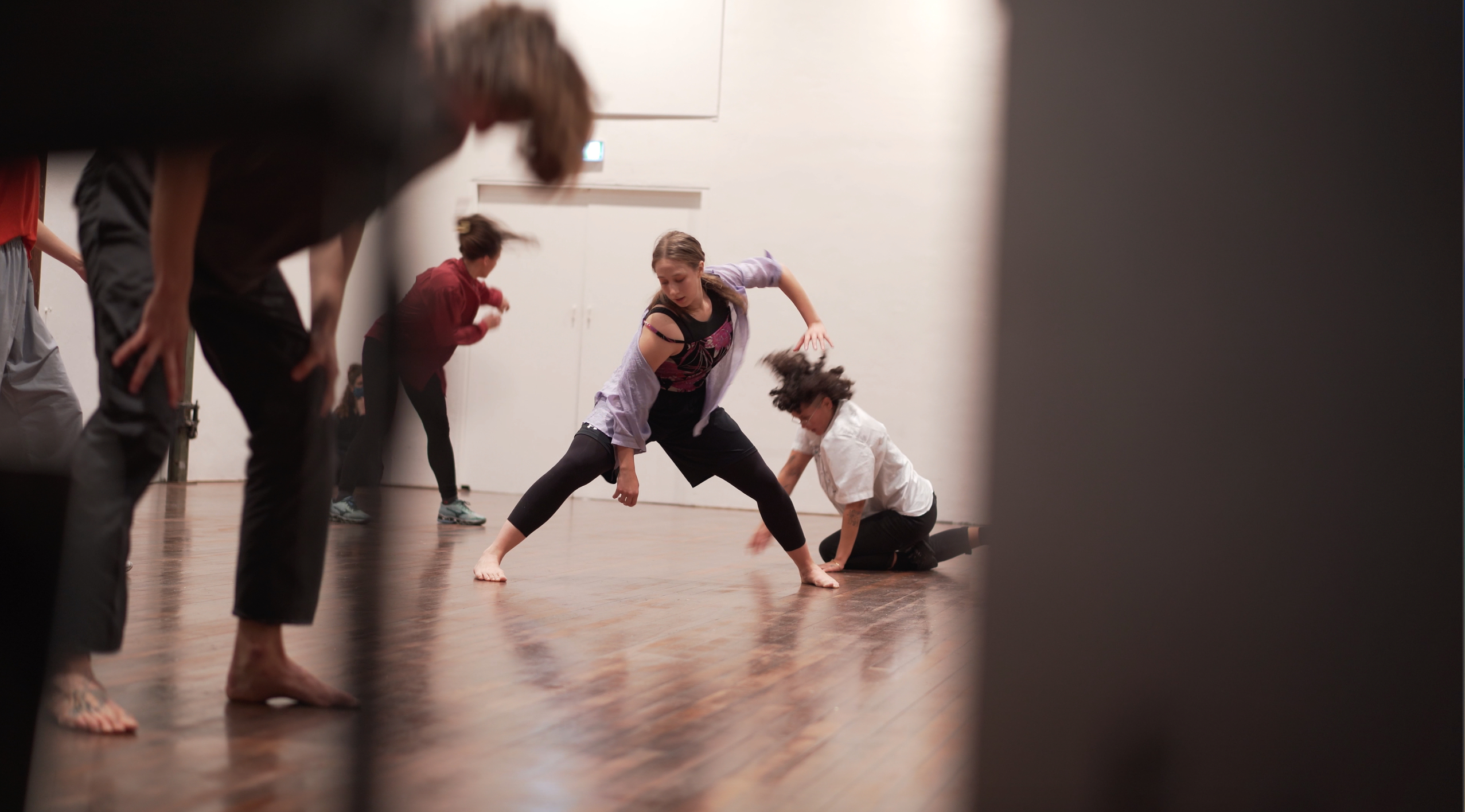



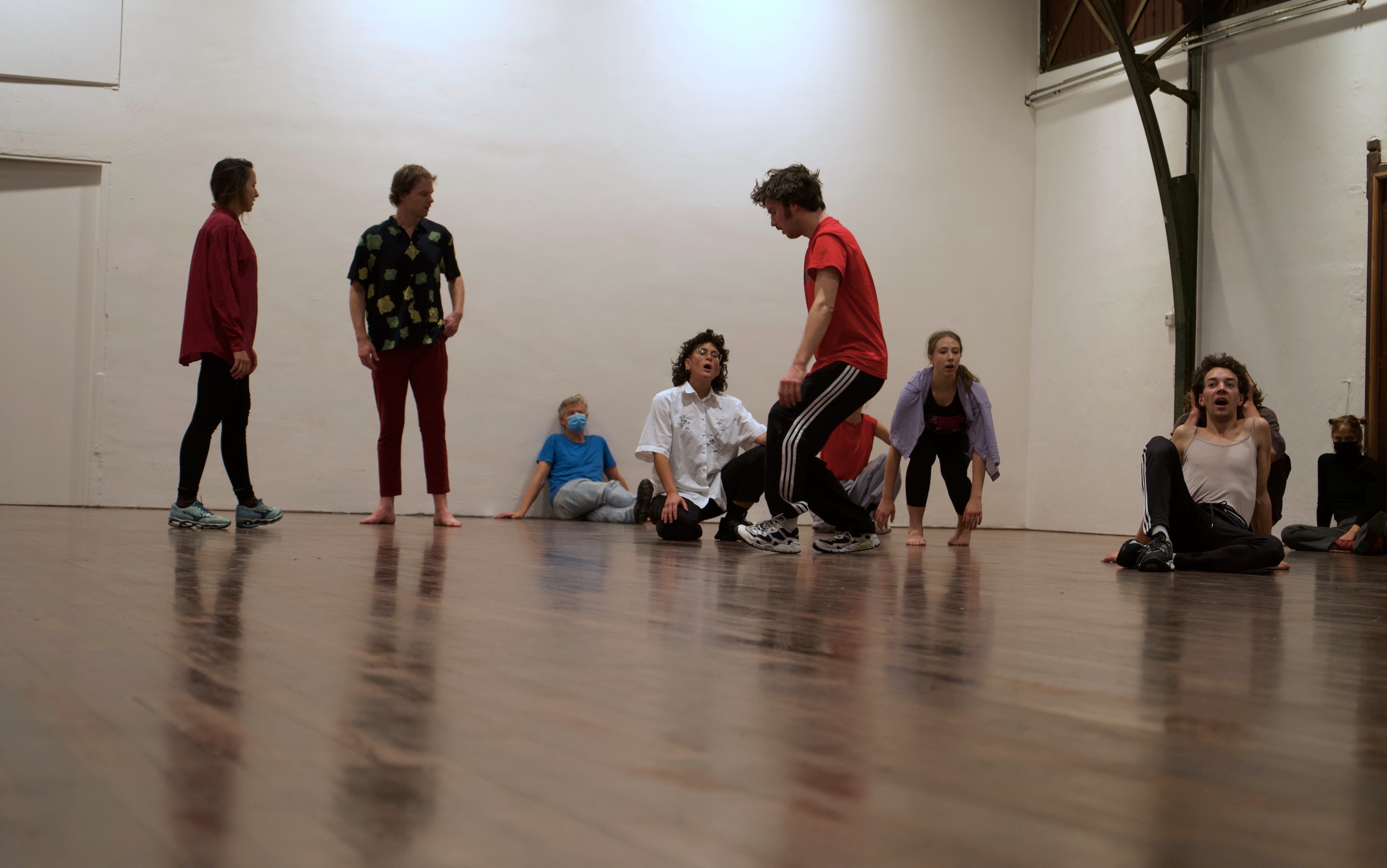
V - When our mind is saturated, memories flood back in.
While the breath stays on its highest intensity, try to slowly walk all together to a specific, previously decided, spot and sit down. Once you have arrived, slowly calm down the breathing. Take in what happened and arrive to complete stillness. Let the following song fade in and the light fade out:
Where are we?
What the hell is going on?
The dust has only just begun to form …
Crop circles in the carpet …
Sinking, feeling, …1
VI - Residual histories of the body.
Before continuing: memorize 5 different, short movement actions which connect to your practice that you shared in the beginning. Tell yourself: „It could be [this]“ and then produce an action. Try to find a variation and playfulness in regard to amplitude, expressivity, intensity, corporeal locality, formality, etc. … Keep the movement short, repeatable and loopable. Perceive these actions not as representative materials that imitate your practice but as various traces that slowly get sedimented within a shared bodily archive.
Once you have 5 short actions, take the verbal presupposition „It could be [this]“, out and share these actions with others so they can learn and memorize them accordingly. Perform each others actions one after the other. All together. In unity. Once you have finished, conclude the work by taking in what happened.
The end.
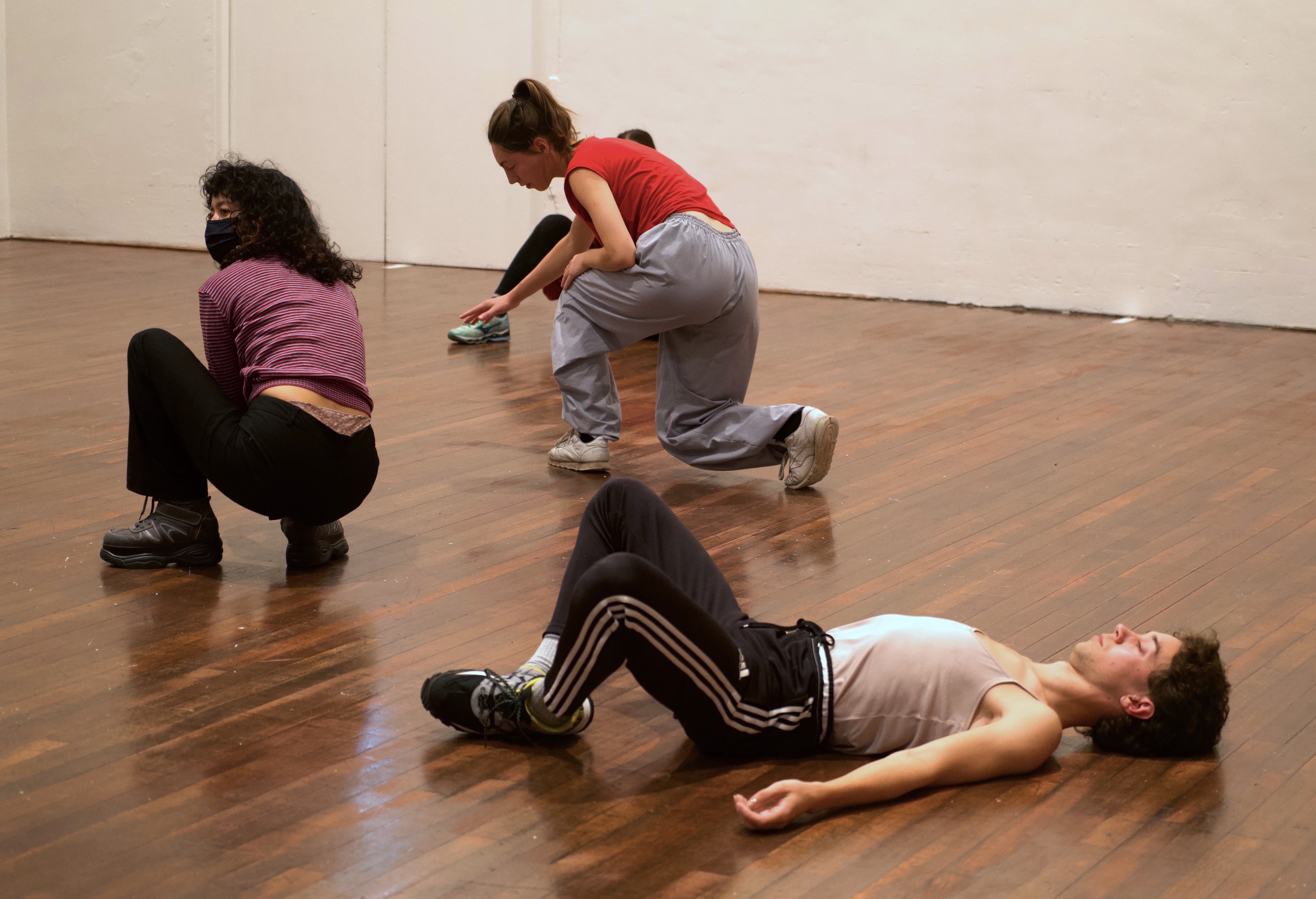




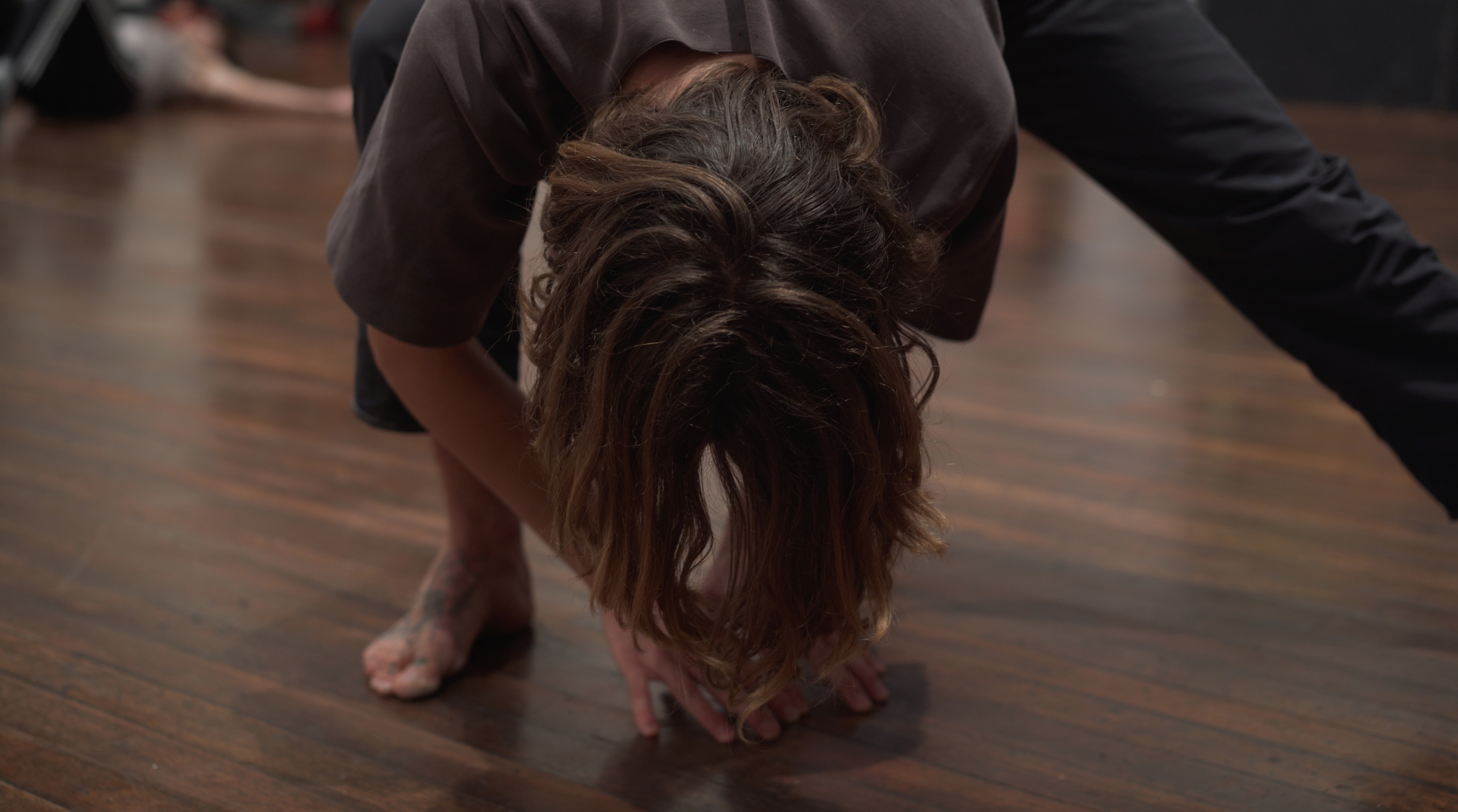
© Photos by Adriana Lasheras and Koen van der Heijden
© Interview/Video by Tamara van den Berg / Veem - House for Performance
FULL SCORE TEXT
︎︎︎
1. This is a story about lost facts.
The work starts in conversation by means of collective, discursive practices that lead to a mapping out of interests. Always enter from the periphery and give all the materials the same value. The map shouldn’t occupy or gate a territory but focus on the flights in-between: about the proximity and/or distance between the subjects and concepts. Go wild but focus on the relation. See the map as a choreographic floorplan, where the object of perception, the future situation is.
Upon finishing think about a newly imagined or already existing practice of yours that connects to the map that has been prior created. See it as a performative statement, a single operation or state in which you describe and later on physically address your practice to a selected viewer. Beside movement, verbal language, written or spoken text may be included. Try not to work with props, etc. - keep it short, simple and embodied.
_
The body as a medium, in all its ephemerality, immediacy and political urgency generates logics and knowledges that refrain from its rational conceptions and instead strive to look for new ways how meaning can arise by subverting the rational and going for the embodied-affective.
Keep the following questions in mind:
- Re.think how you source, generate and perform choreographic ideas and materials within your work.
- Re.cite three questions that you have been revolving around so far.
- Re.discover different gateways in which you move from a material body of knowledge to a performed, staged reality.
- Re.trace additional modes that you have not yet explored within your practices.
- Re.define how physical and material means of knowledge currently feed your work.
- Re.present an unknown territory that embraces unknowingness.
These questions should give rise to an intertextual reflection, an ongoing process and not necessarily to a result. Think about how you think, how new ideas are embroidered into existing ones, which kind of qualities or registers you use and how you embody and communicate your work through a poetical display.
︎︎︎
2. Sharing stories and hearing stories.
Continue to share the practice that you have created with several members of the audience, slowly start to merge each others practices, by linking other peoples endeavors till you arrive together into different forms of loose shaking. See shaking as a poetic practice. Strive to find one collective movement quality by carefully listening and sensing how intensity of the collective changes.
See the collective thereby as a transition-space that gives rise to new ideas, thoughts metamorphoses and performativities. See it as a place of old encounters, new interactions, of physical and metaphysical approaches somewhere „in-between“ fact and fiction, the „Self“ and the „Other“, visibility and invisibility, inside and outside, introspection and reflection … center and periphery.
_
It is all about the space within poetics.
When you watch someone else’s work, you watch someone that has established codes for you to decipher. Shaking as a poetic practice plays with the fact that signs are not always identical to their referents. On the contrary the idea of poetics is hereby not simply understood as means of determining meaning but as a convergence of various logics and signifier that lie beyond a singular „about-ness“. This idea gives rise to the question of meaning and memory in its most ontological form: What does it mean to presuppose collective signifiers? How have I been personally conditioned to signify? How does my lived experience construct how I think and act? How am I signified by others? I.e.: How do we read how are we read?
These questions give rise to the emergence of something else, a speculative space, an „in-between“ where meaning seems to consist of multiple possibilities all single-handedly looking for their future becomings: Meanwhile, the common nominator seems to be the collective.
While saying that, it is of utmost importance to remember that a poetics of memory wouldn’t exist without the politics of forgetting. Loss in that regard permeates every crack and crevice of our becoming in the world. It tends to wash over us. And yet, these are shallow waters in which we navigate in. Water in its elementary, liquid state is not capable of holding a material body of memory. It dilutes itself and washes away all the traces where it has once been enclosed in. Derived from greek mythology the river „Lethe“ has thus become one of the central metaphorical ideas of forgetfulness within a western thought: When does something become invisible? If it is fully diluted is it still present? How can we find practices that live on the threshold between a material body of knowledge and its memory?
It is similar to the ephemerality within performance: a cited action, an intimate encounter, a swift movement, … if one returns thereby to the notion of poetics one could note that the enacted movements within the score speak less about their performance, i.e., their representation but as Judith Butler refers to: more about their performativity.
︎︎︎
3. Re.verb.
Start to slowly intensify the shaking. Once you arrive to a point where exhaustion takes over, let the rhythm of the breath come into the foreground. Keep pushing. Once you arrived at an energetic zenith try to slowly calm down till the shaking modulates and becomes near stillness.
_
Once you seem to get hold of something it tends to slip away.
From this moment, the movement-score sets the communal conversation into the foreground by transgressing from an individual inquiry about ones own personal practice towards collective practices that pick up shaking as a means to reconnect to the body, to let the body speak, to let the body think and to let the body communicate through the work.
It seems to always be an embodied enactment against loss - of an impossibility to retrieve the past. In that regard, trauma theory too speaks of impossibilities, of the inadmissible pasts that forever haunt the present. Trauma already lives in the body, it is impossible to think about meaning and memory in terms of culture, the environment and the body without seeing the inherent trauma behind it as well. How can we understand our present or glimpse into our future if we cannot understand our past? How can we know who we are if we don’t know who we were?
Performativity in that regard seems to be part of a spatial situation, a fold or a gap, a space „in-between“ where meaning strips off its nostalgia to the past by bending backwards and re-questioning its virtue: By thinking about what the encounter evokes in us, what brings us in this times and space together and how this questions, reflects and describes our own vantage onto the nexus of art-making and our world.
︎︎︎
4. Immersive spaces.
Once you have arrived to near stillness, start with a nearly imperceptible rocking motion. Decide beforehand collectively on one shared vector and start rocking back and forth all together, on the same pace. Take your time and change the amplitude incrementally by raising the intensity. Keep pushing together by being together. Don’t shy away from exhausting yourself and/or the image.
At a certain point, let the breath come into play. As you rock all together, the breath is to be kept together like a choir. Once the image has arrived on its zenith, slowly fade down the movement but keep the breath on the same intensity. Arrive to physical stillness but keep the breath on its highest intensity.
_
Repetition implies an almost excessive idea of poetry
„A conscious body is a complex being, it takes place as an interaction of different dynamisms of difference. ‚Differentiation and differenciation‘, or ‚different/citation’ is the name of the double movement of difference. When the actual meets the virtual, a conscious body is created – but created as creative, since it is a being that actualizes the process of its own becoming, in other words, it understands (or misunderstands) itself.“2
Rocking. Rocking. Repeating. Repeating while reorganizing, thus repeating differently. Repeating an idea, whilst reorganizing the idea what is different about it. It seems to be the difference in repetition that accounts for change: the repeated self in all this instances is never the same, there is no structure can persist as identical to itself. It seems to be that the self becomes another with each repeated action, changing it in in its past identity and feeding it with a new embodied presence: that of a new performativity.
It is to say that the intersection between one’s own performativity and the means of repetition is not always to be understood as a voluntary „aesthetic act“ but more as a web of various relational and inter-citational practices that are informed and entangled within broader collective processes by being stipulated with several discursive practices, e.g. the mapping in the beginning of the creation.
Mind the asymmetry? Once uttered rules and guidelines such as the ones in this score-edition come into practice, they start to account for difference, creating a shared space from where people can act, position and distance themselves from. How something changes from one thing to another is often more important than the thing itself. Repetition helps us to remember, to re-remember what once has been: to celebrate difference in all its colorful forms but to fight asymmetry by means of care and horizontal creation principles.
︎︎︎
5. When our mind is saturated, memories flood back in.
While the breath stays on its highest intensity, try to slowly walk all together to a specific, previously decided, spot and sit down. Once you have arrived, slowly calm down the breathing. Take in what happened and arrive to complete stillness. Let the music fade in and the light fade out.
Where are we?
What the hell is going on?
The dust has only just begun to form …
Crop circles in the carpet …
Sinking, feeling, …1
_
The intersection between social remembering and the „Self“ form the preliminary framework through which representations of shared, possibly communal memories can be brought into the foreground. Through the means of several discursive, applied and embodied practices, the score strives to (re-)discover seemingly forgotten places and traces in our memory that live within us and that we are composed of. Often unconsciously, we assign specific memories to distinct locations, both in a topographical as well as metaphorical sense: We create spaces for us to move and navigate in, but how much are we willing to share those? How much are those spaces kept gated and how much do we build bridges in order to communicate with the „Other“? The relationship between practices of remembering and the „Self“ constitutes the basis for a poetic engagement within the score: by re-citing and re-tracing learned movement material, by having conversations and encounters that challenge one’s own virtues, by learning other peoples diverse approaches, by learning how to approach and learn from the „Other“, by critically engaging with traumatic past experiences at a local or trans-national level, ... etc.
The current edition represents a „poetic-appeal“ to work on the dismantling of identitarian, logocentric and eurocentric conceptions of reality towards a more inclusive afterlife - where meaning, signification and subject-formation starts to be re-discovered, re-questioned and re-purposed.
︎︎︎
6. Residual histories of the body.
Before continuing: memorize 5 different, short movement actions which connect to your practice that you shared in the beginning. Tell yourself: „It could be [this]“ and then produce an action. Try to find a variation and playfulness in regard to amplitude, expressivity, intensity, corporeal locality, formality, etc. … Keep the movement short, repeatable and loopable. Perceive these actions not as representative materials that imitate your practice but as various traces that slowly get sedimented within a shared archive.
Once you have 5 short actions, take the verbal presupposition „It could be [this]“, out and share these actions with others so they can learn and memorize them accordingly. Perform each others actions one after the other. All together. Once you have finished, conclude the work by taking in what happened.
The end.
—
Traces have let the body and become material.
As previously referred, information occurs through change and relation, of what it is and how it understands itself. It in that regards connects, next to its performativty, to the self - the understanding of one’s own constitution. The image that the conscious comes up with seems to be a product of its own speculation, the image of itself is the product of an active engagement with its own condition. One’s performance in the world doubles the ontological performativity of difference. The representation of the self is the double-gänger of its own condition, a silent mirror that lives within the imaginary and which is constantly re-discovering itself.
The performer in a movement-score is often understood as the subject that approaches movement as a „task“, where the lived enactment and the content is to be kept separated. The present score-edition counters that conception by seeing the performance and performativity within an entagled, spacial plane. It picks up the motive of an utterance, an „action“, as an improvisatory indication and exploration, referring in that regard more to working methods that emphasize the interface between the person (re-)discovering and what is being enacted, between the performer as living subject and the embodied „archive" as an object of study.
The notion of an archive in that sense can here be understood as various sediments that seem to accumulate through conversation, leftovers that regain a purpose. As an embodied choreographic body, a potential, made up from various traces of the past, all brought into a new context, where the focal point migrates towards a juxtaposition, fragmentation and transformation, giving existing materials a new corpus.
︎︎︎
1 Intro: Imogen Heap (2015). Hide and Seak [Recorded by Megaphonic Records]. In: Speak for yourself. Rondor Music UK Ltd.: LondonWhat the hell is going on?
The dust has only just begun to form …
Crop circles in the carpet …
Sinking, feeling, …1
_
The intersection between social remembering and the „Self“ form the preliminary framework through which representations of shared, possibly communal memories can be brought into the foreground. Through the means of several discursive, applied and embodied practices, the score strives to (re-)discover seemingly forgotten places and traces in our memory that live within us and that we are composed of. Often unconsciously, we assign specific memories to distinct locations, both in a topographical as well as metaphorical sense: We create spaces for us to move and navigate in, but how much are we willing to share those? How much are those spaces kept gated and how much do we build bridges in order to communicate with the „Other“? The relationship between practices of remembering and the „Self“ constitutes the basis for a poetic engagement within the score: by re-citing and re-tracing learned movement material, by having conversations and encounters that challenge one’s own virtues, by learning other peoples diverse approaches, by learning how to approach and learn from the „Other“, by critically engaging with traumatic past experiences at a local or trans-national level, ... etc.
The current edition represents a „poetic-appeal“ to work on the dismantling of identitarian, logocentric and eurocentric conceptions of reality towards a more inclusive afterlife - where meaning, signification and subject-formation starts to be re-discovered, re-questioned and re-purposed.
︎︎︎
6. Residual histories of the body.
Before continuing: memorize 5 different, short movement actions which connect to your practice that you shared in the beginning. Tell yourself: „It could be [this]“ and then produce an action. Try to find a variation and playfulness in regard to amplitude, expressivity, intensity, corporeal locality, formality, etc. … Keep the movement short, repeatable and loopable. Perceive these actions not as representative materials that imitate your practice but as various traces that slowly get sedimented within a shared archive.
Once you have 5 short actions, take the verbal presupposition „It could be [this]“, out and share these actions with others so they can learn and memorize them accordingly. Perform each others actions one after the other. All together. Once you have finished, conclude the work by taking in what happened.
The end.
—
Traces have let the body and become material.
As previously referred, information occurs through change and relation, of what it is and how it understands itself. It in that regards connects, next to its performativty, to the self - the understanding of one’s own constitution. The image that the conscious comes up with seems to be a product of its own speculation, the image of itself is the product of an active engagement with its own condition. One’s performance in the world doubles the ontological performativity of difference. The representation of the self is the double-gänger of its own condition, a silent mirror that lives within the imaginary and which is constantly re-discovering itself.
The performer in a movement-score is often understood as the subject that approaches movement as a „task“, where the lived enactment and the content is to be kept separated. The present score-edition counters that conception by seeing the performance and performativity within an entagled, spacial plane. It picks up the motive of an utterance, an „action“, as an improvisatory indication and exploration, referring in that regard more to working methods that emphasize the interface between the person (re-)discovering and what is being enacted, between the performer as living subject and the embodied „archive" as an object of study.
The notion of an archive in that sense can here be understood as various sediments that seem to accumulate through conversation, leftovers that regain a purpose. As an embodied choreographic body, a potential, made up from various traces of the past, all brought into a new context, where the focal point migrates towards a juxtaposition, fragmentation and transformation, giving existing materials a new corpus.
︎︎︎
2 Horváth, Eszter. (2016). The Other and its Double: Performance and representation revisited. In: Otherness Essays and Studies 5.1, special issue “Otherness and the Performing Arts”. Aarhus Universitet. pp. 204.